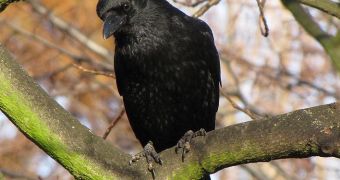As biologists and anthropologists have over the past few years been trying to figure out how is it that crow groups of certain species tolerate birds that appear to be free-loading. Studies have revealed that some members of groups tend to stand around doing nothing to help the community. In other species, when this happens, the unproductive member is kicked out, banished, or even killed. In a recent study however, it was revealed that lazy, unproductive crows play an important role in the community, when producers and dominant breeders become handicapped, the idle birds take on their responsibilities.
The new conclusion is based on studies of Carrion crows (Corvus corone), which live in relatively large groups. Scientists noticed that when hardworking birds suffered accidents, and became handicapped as a result, the lazy ones tended to step up to the challenge, and begin producing for the community. The formerly-idle birds become actively involved in breeding, foraging, and caring for the young. In addition, it would appear that there are several evolutionary reasons for why the working crows tolerate the lazy ones. Larger groups, even if rendered more inefficient in absolute terms by the latter's presence, are more intimidating to predators, and may also be better at foraging for food.
In the experiments that arrived at this conclusion, Spanish researchers from the University of Valladolid in Palencia, conducted two observations rounds. First, they looked at 61 wild crows, living in 17 social groups, across Spain. They observed the animals for three days, with 12 hours of video footage captured each day via hidden cameras. After establishing the hierarchies in the groups, the teams captured one of the top breeders in each of the 17 groups and clipped their wings. They then returned the birds to their communities, and repeated observations. The conclusions puzzled the group, which was led by Vittorio Baglione, an evolutionary biologist at the university, Nature News reports.
The crows with the clipped wings reduced the intensity of their feeding habits by more than 30 percent, due to the clipped wings. When this happened, the birds that had previously been classified as the laziest stepped up to the challenges, beginning to visit the nests, and deliver food to chicks. Five out of eight most lazy crows became the most active members of the community almost overnight. “It's really important to investigate individual variability in helping behavior, because it could help us understand the evolution of cooperation. That's the central dilemma of behavioral ecology that we've been grappling with for a long time,” says Cornell University ornithologist Walt Koenig. “I'd like to believe that this kind of study might shed some light on cooperation in humans and other species that cooperate in subtle ways,” Baglion says.

 14 DAY TRIAL //
14 DAY TRIAL //